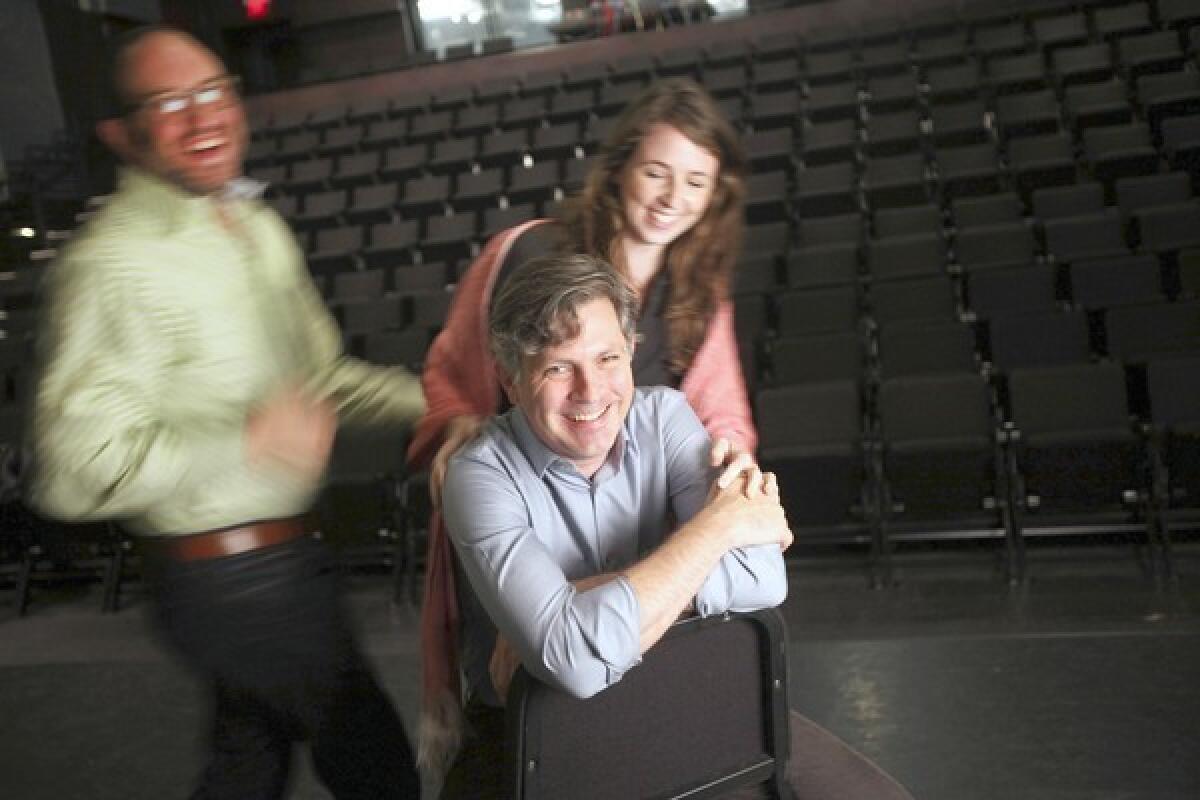Elevator Repair Service takes on the great ‘Gatz’

In his younger and more vulnerable years, director John Collins flatly rejected the idea that theater is about bringing words on paper to life. He instead placed his trust in actors, space and movement as the most basic building blocks of stagecraft.
“I wanted my plays to be made from what happened between actors moving around in rehearsal,” said Collins, founder of the New York-based experimental theater company Elevator Repair Service. “That to me was fundamental to theater, more fundamental than text. And for years I avoided text.”
Then a few years ago, Collins and a couple of actor colleagues were hunting for a new project. Brainstorming ideas in a theater’s back room, they started experimenting with a scenario in which a man comes into an office and begins to read a book aloud.
PHOTOS: Arts and culture in pictures
Against that utterly drab backdrop, the universe of the printed page begins to unfold before the audience. The man and his fellow office workers transform into vivid characters named Jay, Daisy, Tom, Nick and Myrtle. Musical notes and urban sound effects drift into the action. The ‘80s office setting, crammed with paper and old-model computers, somehow morphs into the bustling streets of New York City or a swinging Jazz Age party at a Long Island mansion.
The book in question, of course, is “The Great Gatsby,” F. Scott Fitzgerald’s classic 1925 novel about a mysterious young Midwesterner in pursuit of a beautiful, rich woman and a romantic vision of the American Dream that seems “so close he could hardly fail to grasp it.”
The novel has proved famously difficult to adapt for film or other dramatic purposes. “Gatz,” the adaptation by Elevator Repair Service, does not depart from the text at all: It is a word-for-word, 61/2-hour enactment.
The show has become the company’s international calling card and is among the most heavily praised achievements in U.S. theater in years. It opens a nine-performance run Wednesday at REDCAT in Walt Disney Concert Hall.
Collins and some of his colleagues talked about the show while they were in Los Angeles last month for a fundraiser benefiting REDCAT and CalArts. He returned this week, and on Monday he was at the theater, helping to build sets and rig lighting for a full run-through Tuesday.
Clearly, Collins has made peace with text, which he suggests is easier to do when the words are those of a masterwork such as “Gatsby.”
“What the book does so well, or what Fitzgerald does so well, is write,” Collins said. “It’s not as though he were a second-rate writer who had the genius idea to write about big parties and fancy cars. Or even a kind of tragic love story. We wouldn’t still be reading that book now if somehow his words were dispensable.”
That’s why it’s strange, Collins said, that the various Hollywood film versions of “Gatsby,” including the 1974 version starring Robert Redford as the title character and Mia Farrow as Gatsby’s object of desire, Daisy Buchanan, with a screenplay by Francis Ford Coppola, have treated Fitzgerald’s prose as somewhat dispensable. When movie adaptations of “Gatsby” aren’t skipping over resonant narrative passages, they’ve tended to smother the screen with scenes of colorful, glamorous goings-on.
Yet the novel’s core meanings and most profound reflections are to be found in the first-person ruminations of Nick Carraway, Daisy’s cousin and the book’s eminently sensible and truthful narrator. In the Elevator Repair adaptation, the marathon role is handled by one actor, either Scott Shepherd or Ben Williams, who’s onstage for the entire show.
“Adaptations can’t resist filling in scenes that Fitzgerald didn’t write. It’s as if they don’t recognize that some of the genius of the book was keeping it to Nick’s perspective, in a way,” Collins said. “I think it’s just too hard for filmmakers to resist sometimes getting a little drunk on all the period details without being able to see the sort of heartbreaking real-ness of who Gatsby really is.”
To keep its own focus and that of the audience on Fitzgerald’s words, the Elevator Repair Service production deploys a number of strategies. Actors were chosen who looked more like office drones than fashion models. Costumes and props were minimized. The office, a deliberately “anachronistic and completely inappropriate setting for the novel,” as Collins puts it, serves as a starkly neutral counterpoint for the action that’s being described.
“The novel itself is a kind of ghost in our production, that depending on the scene will materialize completely and then disappear,” Collins said. “And it’s the same with the actors. I think of the [actors] as being haunted by these characters sometimes.”
If Hollywood adaptations have tended to overstuff “Gatsby” with period panache, the Elevator Repair Service production sometimes had to find ways to put in what the novel leaves out. Because Fitzgerald describes certain key actions in elliptical ways — including three characters’ deaths — a main challenge was deciding how to represent these events onstage, despite the absence of narrative detail.
Robert Cucuzza, who portrays Tom Buchanan, Daisy’s macho, philandering husband, points to a party scene in which Tom gets drunk and ends up punching his mistress, Myrtle Wilson, and an apartment gets trashed.
“I have very few lines in that scene, which is 15, 20 minutes,” Cucuzza said. “And I probably have five or six lines. But I’m onstage the entire time, creating much of that mess myself: getting drinks, throwing papers, knocking over a chair, falling over a couch, dropping bottles. And none of that is in the book.”
Whichever approaches have been taken over the decades, “The Great Gatsby” has endured many incarnations and no doubt will experience a few more. (Baz Luhrmann’s musical version, starring Leonardo DiCaprio and Tobey Maguire, is scheduled to open this spring.)
Kristen Sieh, who portrays several characters in “Gatz,” agreed that most Hollywood adaptations of “Gatsby” glide over the heart of the book. She suggested that a director who’d be content to take a step back to let the story tell itself might serve Fitzgerald’s material best.
“I’d love to see P.T. Anderson do it, or like Jim Jarmusch,” she said, “somebody who’s so obsessed with letting something just be what it is, and not telling you what the moral of the story is and not tell you even what the story is.”
“Gatz,” Collins said, demonstrates the ability of the novel to survive “the very strong theatrical challenge that we pose to it: Let’s see if this story can survive the ridiculousness of being staged as the backdrop of an ‘80s back office.”
“I hope what people are left with is in some sense the power of your own imagination, when you’re fed writing that is this great.”
MORE
INTERACTIVE: Christopher Hawthorne’s On the Boulevards
TIMELINE: John Cage’s Los Angeles
PHOTOS: Arts and culture in pictures
More to Read
The biggest entertainment stories
Get our big stories about Hollywood, film, television, music, arts, culture and more right in your inbox as soon as they publish.
You may occasionally receive promotional content from the Los Angeles Times.











